REMEMBERING JAMI SUBRAMANIAM

23 August 1940 to 27 November 2013
Jami Subramaniam Jami Veera Naidu, always remembered as Jami Maniam was one of those chosen gems who was constantly on the move for the Faith from the day he accepted the Faith during the Ten-Year Crusade period. He had made Bahá’u’lláh and His teachings the centre of his life. Throughout his days his thoughts were centred on how the Faith needed to be served. His noble, concentrated, and exemplary efforts in the teaching field are forever graven upon the pages of history in Malaysia.
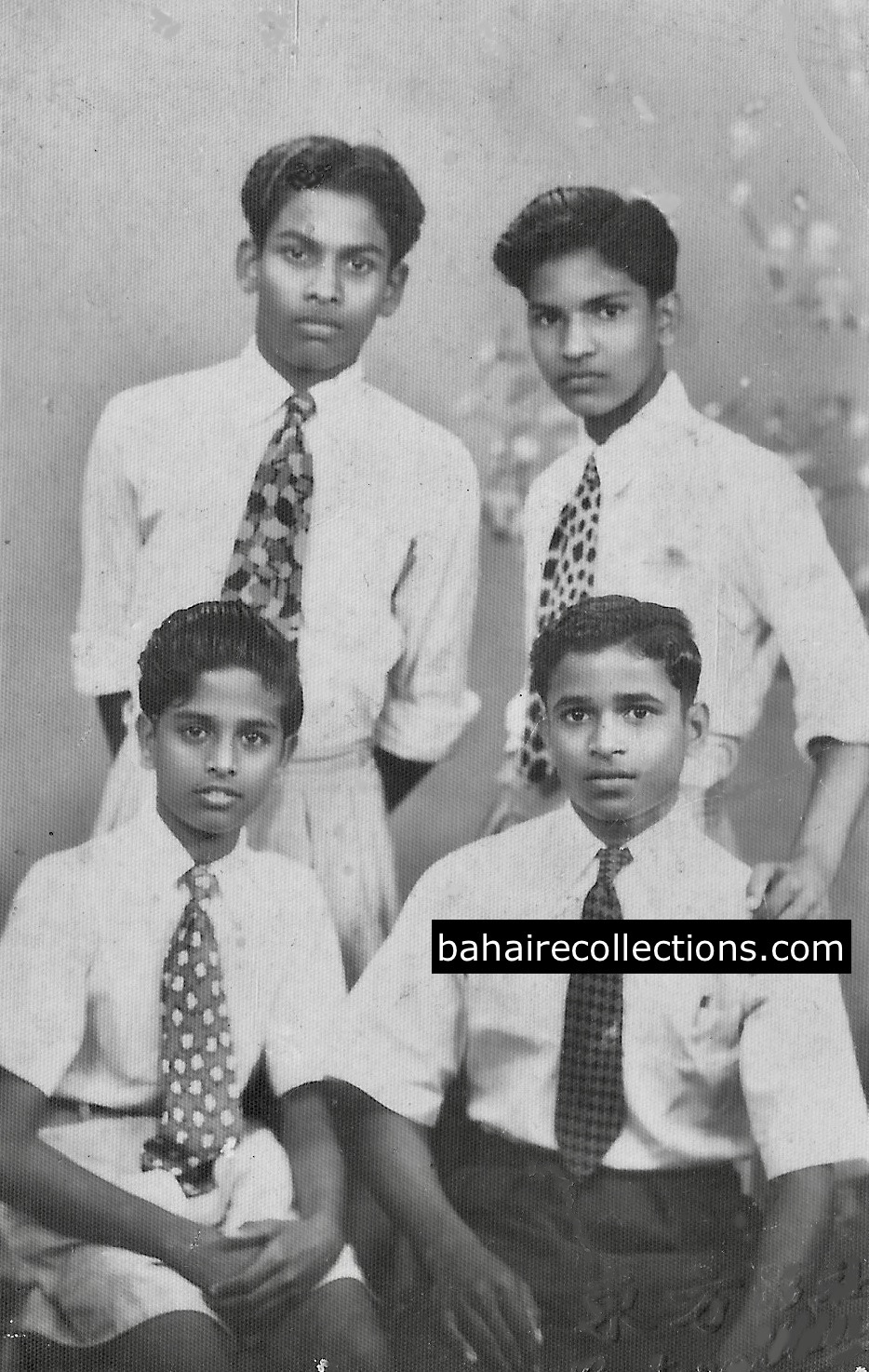
Young Jami is seated at right, with relatives
Jami accepted the Bahá’í Faith in 1957 in Malacca, together with Maniam Muthaiah or fondly known as “Penghulu Maniam” who were students at the Methodist School in Malacca. They were active church-going members and almost became baptized when the Healing Message of Bahá’u’lláh wafted over them. Following a thorough investigation by reading and attending firesides, they accepted the Faith, and there was no turning back. Jami exerted all his energies in serving and the Cause. One major turning point at the very early stage was the first Bahá’í summer school held in December 1957 in Malacca. The presence of some fifty believers from some parts of Malaya and Singapore, and the participation of Hand of the Cause of God Dr. Raḥmatu’lláh Muhájir had a profound effect in his soul, that led to his confirmation and conviction in the Faith. In the early years, he had the priceless privilege of basking under the guidance of other visiting Hands of the Cause such as Mr. Ṭaráẓu’lláh Samandarí, Mr. Abu’l-Qásim Faizi, Miss Agnes Alexander, Mr. Shu’á’u’lláh `Alá’í and Amatu’l-Bahá Rúhíyyih Khánum, followed by other Hands in the later years. Filled with absolute admiration for these Hands, he committed to memory some of their words of guidance and related to the friends throughout his Bahá’í life.
Jami never missed any local gathering held in Malacca town during his bachelor days starting with the first Bahá’í summer school of 1957. Jami attended all other summer schools and gatherings held in Malacca, or elsewhere in the country including regional conferences. To most of these Bahá’í activities, he would take his entire family. One could not say that Jami missed very few conferences in his Bahá’í life. One would go to any conference and meet Jami there.
The Sunday Classes conducted for the youths at the Malacca High School in 1958 too had assisted much in adding his knowledge of the Faith. The classes were conducted ably by Kumara Das, Anthony Louis, and Saurajen, for whom Jami always showed his gratitude. He was further nurtured into the Faith by the late Leong Tat Chee, whom Jami considered his Bahá’í mentor.
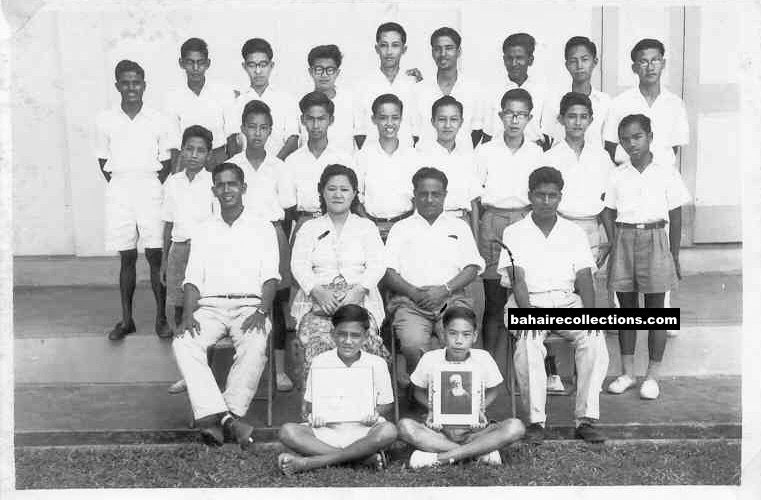
Sunday Class at Malacca High School, 1958. Teachers are seated (L-R) Anthony Louis, Lena Saurajen, G. Saurajen, and Kumara Das. Back row – standing at the extreme left is Jami Subramaniam, fourth from left is Errol Seow Hoon Hin, fifth from left is Leong Ho San, sixth from left is Purushothman Nair
In the early days when Jami had accepted the Faith, he was going through untold difficulties. Unable to do anything else, Jami went to see Leong Tat Chee. The advice and guidance that Leong Tat Chee gave Jami sank deep into his heart. After carefully listening to his story, Leong Tat Chee told Jami, “When we undergo problems we have to go to the root of the problem to see if they are tests from God or are the results of our own making. If you are convinced that it is a test from God, I am sure you know that suffering and tests are part and parcel of Bahá’í life. Once you become a Bahá’í you may escape anything, but you can never escape the tests. We have the assurance that tests are meant for our own spiritual growth, and we are aware that God tests only those whom He loves most. If I were you I would pray for strength to face and overcome the tests. On the other hand, if this is the result of your own making, then you have to meditate if your deeds could have made Bahá’u’lláh unhappy. Only your conscience would tell you if you have committed any sin. You need not confess to me, as confession of sin is not allowed in the Faith. If you feel you had done something to upset Bahá’u’lláh you can always beg with all your heart to seek His forgiveness and remember Bahá’u’lláh is the forgiver of the most grievous of sins. Put your whole reliance in Bahá’u’lláh and serve Him more than before and He will assuredly come to your relief with all His Infinite Mercy.” After getting this explanation from Leong Tat Chee, Jami went home with a relieved heart. Thereafter Jami would always seek the root of any problem that came by in his life and act in accordance with the advice of Leong Tat Chee. And that was the advice of Leong Tat Chee, that Jami would give almost word for word to others seeking his advice during their moments of heedlessness.
Having sought shelter under Leong Tat Chee, Jami undertook several teaching trips with him in the state of Malacca and Negeri Sembilan. As Jami would recall later the conversations with Leong Tat Chee in those trips were nothing but deepening sessions. Leong Tat Chee himself loved Jami, and throughout the time when the former was active, he kept sending Jami postcards with lovely Bahá’í quotations.
Since the day he accepted the Faith, Jami was an active promoter of the Faith and was always obsessed with teaching. At any given opportunity he found ways and means of promoting the Bahá’í teachings. All who knew Jami had known him as a Bahá’í, as he would introduce himself as a Bahá’í and hand out Bahá’í pamphlets which he always carried with him.
On completion of his studies, Jami joined government service in the Ministry of Public Works. In 1963, Jami was posted to Merlimau town in the state of Malacca as Timekeeper with the Public Works Department. It was in that year that with the initiative of Jami the first Local Spiritual Assembly of Merlimau was elected, with Jami serving as Chairman of the Assembly. While there he took an active part in promoting the Cause, including organizing the first Chinese fireside in the Merlimau Chinese Library on 29 August 1963. He invited Leong Tat Chee as the speaker and the latter was very impressed with the proactive role Jami was playing. On many occasions, he used to be the prime mover of activities and did not hesitate to undertake teaching trips even when there was no one to accompany him on such trips. He was always an independent teacher of the Faith.
Yet one more area of service was bringing the Faith to the aboriginal people in the jungles of Malaya in the company of Leong Tat Chee. In the early 1960s, the Seremban Bahá’í Centre was a hive of activities. Jami attended almost all Bahá’í activities held in the Seremban Bahá’í Centre. He supported the activities of the Seremban Bahá’ís, especially in field teaching.
In 1964, he was transferred to the neighboring town of Rompin, this time as a Technician with Public Works Department. There too Jami initiated the forming of a Local Spiritual Assembly, and an Assembly was elected on Ridván that year with Jami holding the position of Chairman. Sadly with Jami moving into Rompin, the Assembly in Merlimau faced a setback only to show the lead Jami had taken in that community. From Rompin, he was actively moving into many parts of Negeri Sembilan for teaching activities.
From the very early days, Jami was very fond of local and international Bahá’í gatherings as he felt that such gatherings not only generated much spirit but were also instrumental in infusing much knowledge on the Faith. Jami had never missed any national convention, starting with the first convention in 1964.
In whatever Jami did, he always wanted to reflect the teachings of the Faith. He married Miss Subbamah who accepted the Faith through her brother G. Appala Naidu in 1964. Appala Naidu himself accepted the Faith through Jami in 1964 when the former was a trainee teacher. When deciding to get married to Miss Subbamah, Jami ensured he had a full Bahá’í wedding. There was strong opposition from some family members and relatives for having not having the wedding in accordance with the customs of the community he came from. While facing them with heroic fortitude, Jami never wavered on the Bahá’í law of marriage. The Bahá’í wedding took place at Rompin town on 14 August 1966, with Leong Tat Chee, mentor of Jami conducting the wedding. It was a rare sight for members of the public to see a person from Chinese background conducting the wedding for a couple from an Indian background. That was one of the earliest Bahá’í weddings in that area which attracted much attention from the non-Bahá’ís in the Kuala Pilah-Rompin belt at a time when Bahá’í marriages were not common. His closest friends such as Mrs. Lily Chinniah from Jasin, Mrs. Lily Ng and Mr. K. Rajah from Seremban town, Mr. Satanam from Port Dickson, and Mr. Vasudevan from Malacca were happily present. Mrs. Subbamah accepted the Faith and became Jami’s strongest supporter in all Bahá’í activities, often following him for teaching activities, and returning past midnight. Throughout their lives, Jami and his wife provided the best hospitality to visitors. There could be not a single visitor who would leave their house without partaking of some meal.
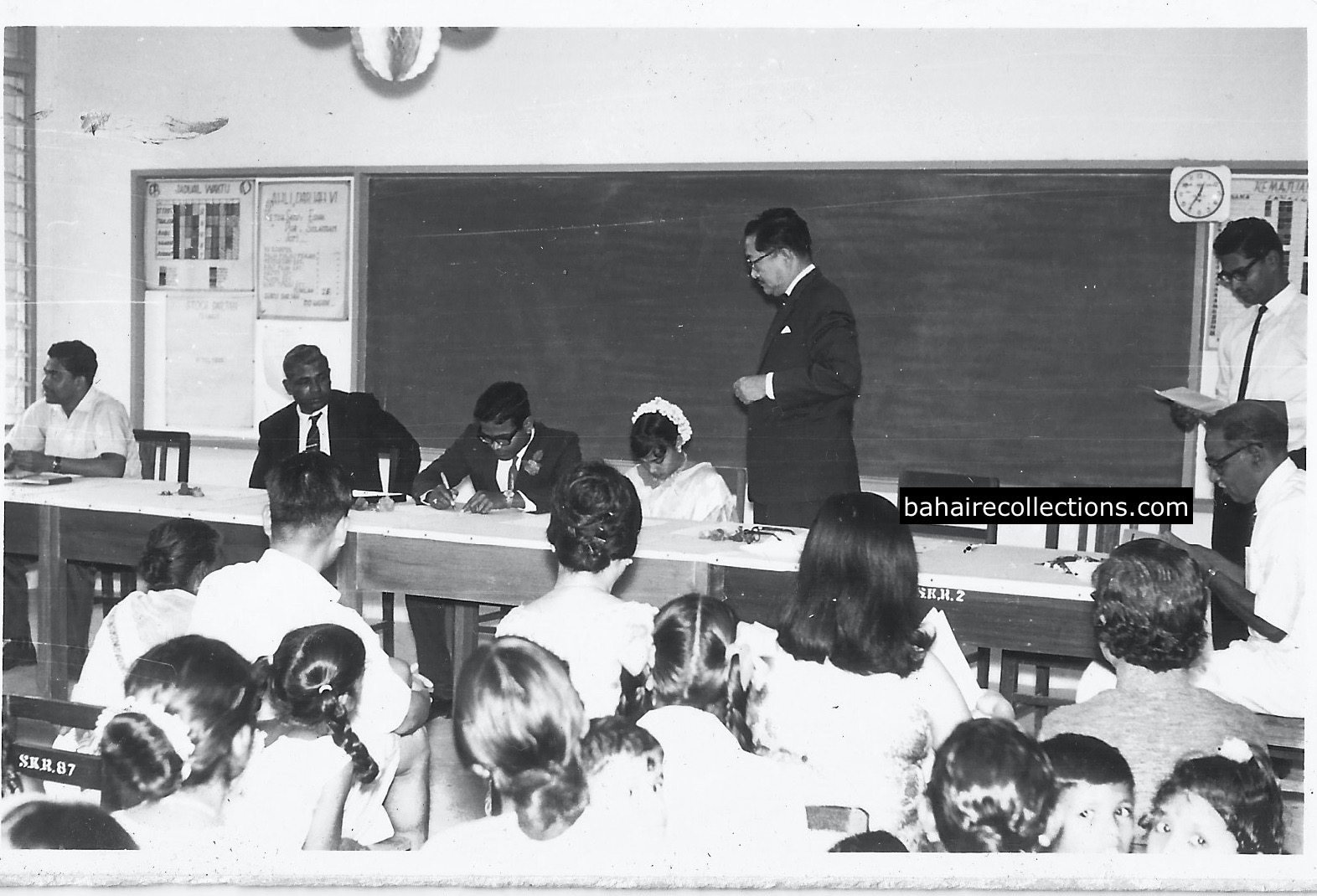
Leong Tat Chee conducting the wedding of Jami. Seated at the extreme left is Satanam and to the extreme right is K. Rajah. Vasudevan stands at the extreme left.
Jami took much liking for the Bahá’í visitors, particularly for all the Hands of the Cause of God who visited Malaysia. Jami had never missed the visit by any Hand of the Cause to Malaysia. In 1965, Mr. Hushmand Fatheazam, then a member of the Universal House of Justice visited the Bahau area. As Jami was the only one who had full knowledge of the entire area and was well equipped with transport means, the Bahá’ís sought his assistance in informing the believers of the imminent visit by Mr. Fatheazam. He single-handedly went around on his white and blue coloured Lambretta scooter informing the Bahá’ís about his visit. Only a handful of them came to the visit by Hushmand Fatheazam in Ladang Geddes. The angry Jami Maniam was fuming with madness, “If I go around telling them that a film show is to be screened in the estate, all will come in full force. But if I say an important person is coming, they could not be bothered.” It was Jami’s nature to always take Bahá’í matters very personally to his heart, and he took full ownership and responsibility as well.
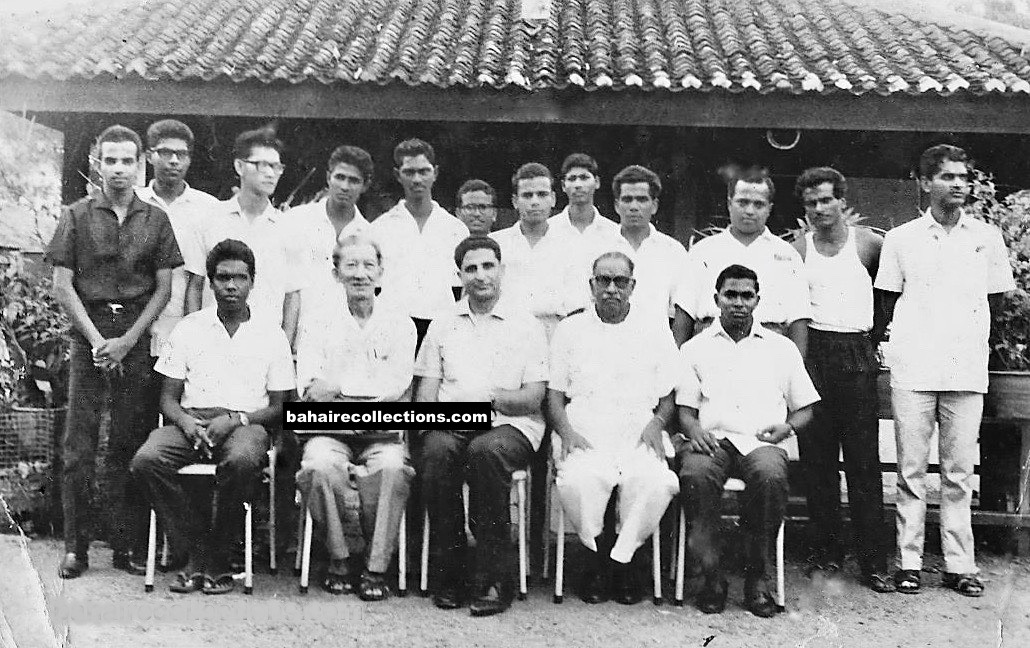
Hushmand-Fatheazam in Ladang Geddes Estate, 1965. Back Row: Nagendran, Allan Chai, Lingam, Kaniappan, Jami-Maniam and Isaac D’Cruz. Seated L-R: Paul Appadurai, Yankee Leong, Hushmand Fatheazam, K. Rajah and Sabapathy.
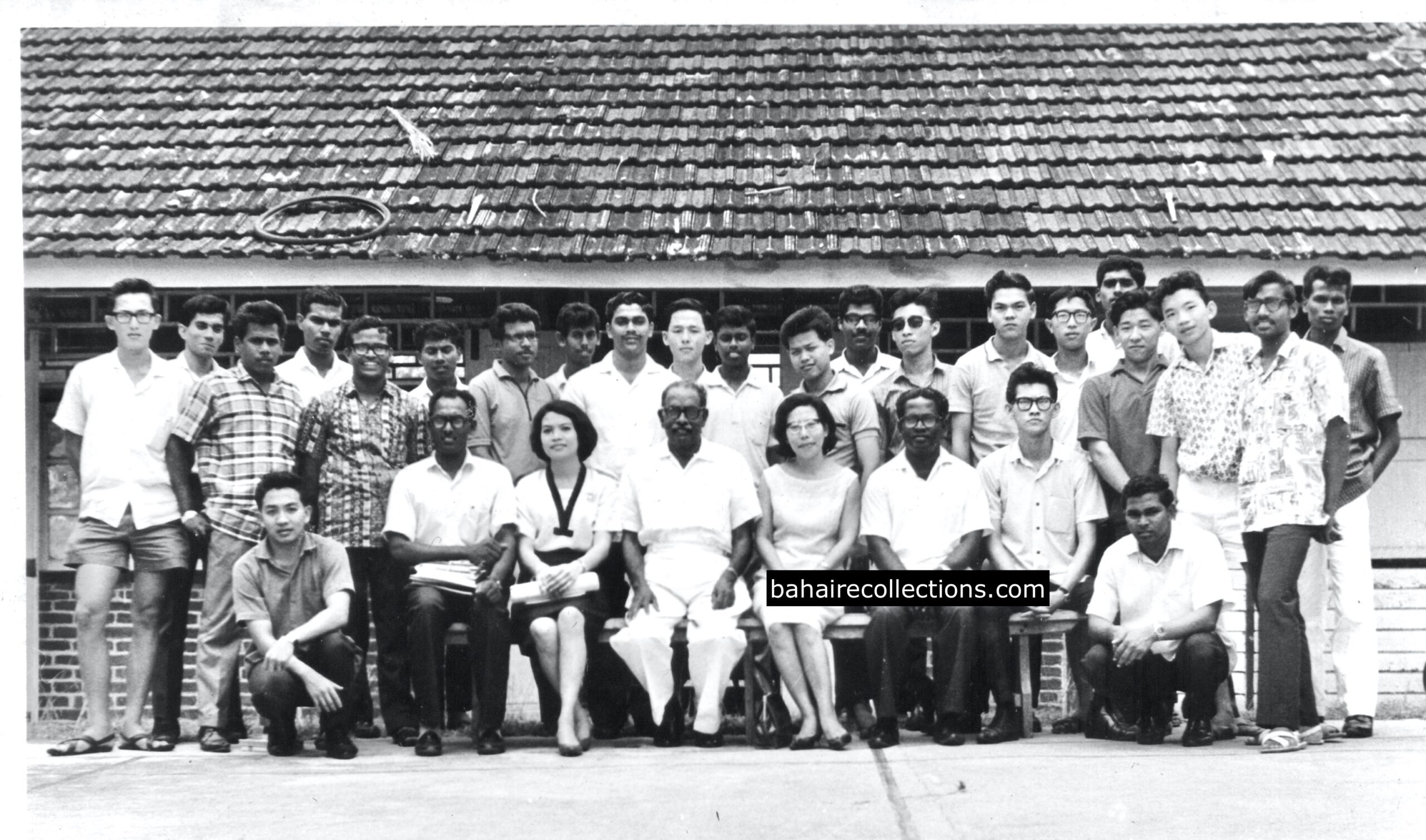 Bahá’í Gathering in Kuala Pilah, February, 1966. Squatting extreme left is Jack Tan, and squatting extreme right is late Sabapathy. Seated extreme left is R. Mariappan, at centre is K. Rajah followed by Lily Ng and Steven Manoharan to his right. Jami is standing fifth from left, G.A. Naidu seventh from left. Satanam standing in white right in the centre. Nagendran is standing thirteenth from left.
Bahá’í Gathering in Kuala Pilah, February, 1966. Squatting extreme left is Jack Tan, and squatting extreme right is late Sabapathy. Seated extreme left is R. Mariappan, at centre is K. Rajah followed by Lily Ng and Steven Manoharan to his right. Jami is standing fifth from left, G.A. Naidu seventh from left. Satanam standing in white right in the centre. Nagendran is standing thirteenth from left.
Jami carried out teaching activities in the most meticulous ways. Jami was a strong believer in harvesting to the maximum in any receptive area. From Rompin town he used to travel to the estates around almost daily to teach and consolidate. He believed that teaching and consolidation must go hand in hand. His deepening tool was the book Bahá’u’lláh and the New Era.
Whenever he entered any plantation settlement or estate for teaching activities, he made it a point to pay a courtesy call upon the estate managers to appraise them of the teachings. That wise approach which he learnt from Hand of the Cause of God Dr. Muhájir was to diffuse any possible opposition and to respect the management. Having won their support, he would next meet the labourers in their quarters. This was the kind of carefully planned and wise teaching method he employed with great wisdom, through which possible opposition at the management was averted.
Jami knew the timing as well when teaching in the estates. He would enter the estates in the evenings on his Lambretta in the evenings when the youths would have just completed their football games. He would then gather them around and teach the Faith. When they accepted the Faith, he would identify some promising youths and request them to open up the neighbouring estates, even though their knowledge of the Faith was superficial. When they showed hesitation, he would tell them, “Pray and say whatever comes to your heart.” He would then encourage the youths to organise children’s classes in the estates using children’s class materials that Dr. Muhájir had left behind in the hands of early believers. Once there was a sizeable number of believers, Jami would encourage holding of Nineteen Day Feasts, and he himself would be present in those Feasts. Jami personally ensured that following the acceptance of the Faith, the new believers were immediately engaged in attending Nineteen Day Feasts, as a starting point in nurturing them into maturity.
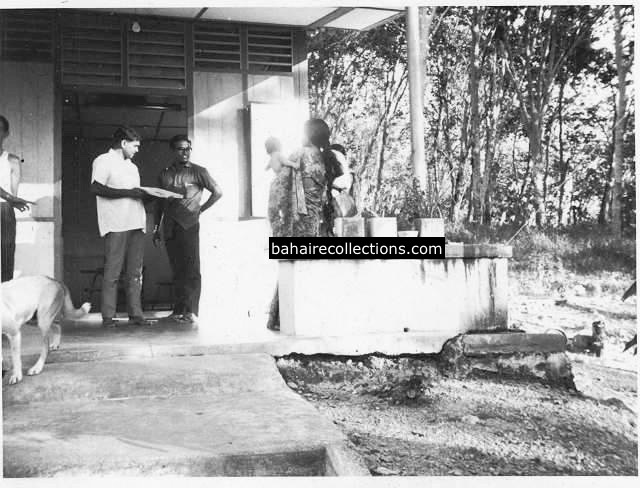
Jami in the Bukit Tinggi estate in 1966
Meanwhile, in 1965 the National Spiritual Assembly of Malaysia sent out a letter to the Malaysian Bahá’í community on the urgent need for carrying out mass teaching. Jami responded immediately. Within a short period of time, mass teaching was reported in the Kuala Pilah-Rompin-Bahau area, where Jami was carrying out aggressive teaching activities. By the later part of the 1960s, Jami had emerged as one of the strongest pillars of the Bahá’í community of Malaysia, earning the appreciation of the National Spiritual Assembly of the Bahá’í s of Malaysia. A circular from the National Spiritual Assembly to the Local Spiritual Assemblies in Malaysia dated 10 February 1967 quotes a letter from Jami as follows “With joyful hearts we wish to inform you that we have 236 believers in all of Kuala Pilah area. God willing, we will fulfill Negeri Sembilan’s target of 500 new believers, which was given by the NSA’s 18 Month Plan. Request prayers.”
In 1966, Jami took the Faith to the Orissa-speaking people in Negeri Sembilan state. The Orissa are the people who had come from the Odissa state in India to work in the plantations in Malaysia, with a very high concentration of them in the state of Negeri Sembilan. Jami gave the Faith to the Orissa people in Bukit Tinggi Estate near Rompin town. Soon there were some ten believers there and Jami deepened them in the Faith, including Mr. Ongkodoh Samu, working in the management of the Bukit Tinggi and his two other brothers Mukundo and Srepathy. Jami as one who would use new believers to establish new contacts took Ongkodoh to the Batu Bersawah Division of the Jerampadang Estate. Many Orissa people accepted the Faith here. Jami was assisted by other believers in developing the Faith in these places. The time came when in the Batu Bersawah Division, the Nineteen Day Feasts were held with grand dinners. They were so strong in the Faith that they abstained from working on Naw-Rúz days while those practicing the Hindu religion went to work, and on the Hindu holy day of Diwali (Deepavali), the Hindus would abstain from work while the Bahá’ís went for work.
Jerampadang Estate had three Divisions- the Batu Bersawah Division, the Kepis Division, and the Hospital Division. Jami also took the Faith to the Kepis and the Hospital Divisions as well and the Faith came to be well established in all these Divisions. The management of the Kepis Division gave a separate building, a cretch, to be used for Bahá’í activities. Hand of the Cause of God Dr. Muhájir who saw this area as very receptive to the Cause had also visited this area in 1967. When Hand of the Cause of God Mr. A. Q. Faizi wished to visit an estate area in his visit to Malaysia in December 1968, the National Spiritual Assembly of Malaysia arranged for him to visit the Kepis Division of the Estate where the Faith was well established.
In 1967, Jami reported to the National Spiritual Assembly that estate communities in the Rompin area had recorded almost full attendance at the Feasts. Jami took out his own money to sponsor several youths to go for conferences to get them deepened in the Cause and to gain the Bahá’í spirit. In those days Bahau town in Negeri Sembilan was the main town where large-scale gatherings were commonly held. In 1967, members of the National Teaching Committee met in Bahau for a conference where more than 70 friends had gathered. At this gathering, Jami, as Chairman of the conference spoke with enthusiasm on the growth of the Faith in the area. Jami remained an active believer in Rompin from 1965-1969.
Jami was a firm believer in proclaiming the Faith by celebrating Bahá’í holy days. At a time when very few homes were opened for Naw-Rúz celebrations, Jami took extra efforts in celebrating Naw-Rúz of 1968 on a grand scale with a tea party followed by dinner for 80 people. This event was published as national news in the Nineteen Day Feast Newsletter of the national institution.
While in Negeri Sembilan, Jami concentrated on bringing the Cause to the Telugu-speaking people, with Jami himself well versed in this mother tongue. Jami joined Rama Naidu and G. Appala Naidu in bringing a large number of those from the Telugu-speaking community in Negeri Sembilan state into the Faith. These three worked as a team and at times as individuals, taking responsibilities for different areas of the state of Negeri Sembilan.
From Rompin, Jami left for the neighbouring town of Kuala Pilah in 1969. His transfer added to the strength of the community in Kuala Pilah town. The year 1969 became a turning point in his service to the Cause. At the end of that year, Mr. Raymond Peter from Malacca was leaving for pioneering to Sri Lanka with his wife Joan and wanted to hand over the management of his family’s typewriter business to a Bahá’í. Peter approached Jami and explained the urgent situation. Jami was holding a secured government job that provided good perks, prestige, and stability and a would provide good pension upon his retirement. But looking into the earnest request of a believer who was going off to pioneer, Jami resigned from his well-paid and respected government job with the Public Works Department. And Jami left the state of Negeri Sembilan for Kuala Lumpur, after leaving traces that were to be remembered forever.
In taking over the management of Peter’s family business, Jami sacrificed all his perks but took consolation that he was able to support a fellow believer to pioneer. Not knowing the tricks and trades in business, he had to start from scratch in the new and unknown business territory. With that Jami moved into the Kampong Pandan area in Kuala Lumpur at the end of 1969. Jami managed the business for Peter and built it up to a higher level. During the times Jami lived in Kuala Lumpur, he served on the Local Spiritual Assembly of Kuala Lumpur and became an active member of the community.
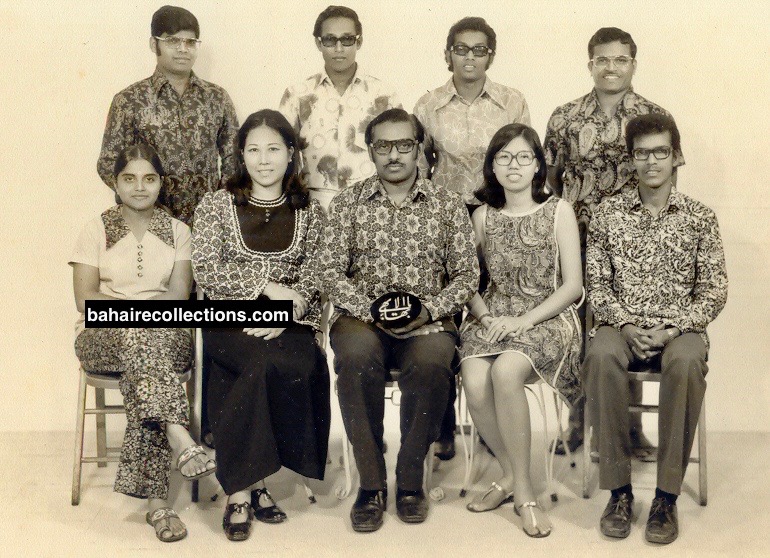
Local Spiritual Assembly of Kuala Lumpur, 1973. Standing L-R: A. P. Arumugam, Machamboo, Govindasamy and Jami Maniam. Seated L-R: Suguna Arumugam, Lily Chinniah, Dr. M. M. Sreenivasan, Yaw Kam Sim, C. Kanagaratnam
When Peter returned to Malaysia in 1973, Jami handed over the business to him and was looking for a livelihood. Jami then moved into the town of Kajang in 1975 where he had to be on his own. The only skill he had in his hands was the servicing of typewriters. He then started a typewriter servicing business under the name of Zarina Enterprise, named after his eldest daughter. This business took him to many governments and private offices in central Malaysia. And his car was loaded with Bahá’í pamphlets and literature to be distributed to his clients.
At a time when Jami moved into Kajang, this community was struggling to thrive. That was predominantly a Tamil-speaking community with Jami and a handful of others who had knowledge of the English language. Bahá’í literature was not widely and readily available in the Tamil language. Jami saw the situation and took upon himself the task of deepening the Tamil-speaking believers in Kajang and other several rural communities in the peripherals. It was in Kajang that Jami became the key motivator for more than 30 years. He emerged as a prime figure in promoting the cause in nearby estates and small towns. When there was no Bahá’í Centre in Kajang, he offered his house for Bahá’í activities. His house became a default Bahá’í Centre. Even when a few houses were rented to be used as a Bahá’í Centre, friends continued to gather in the home of Jami for activities.
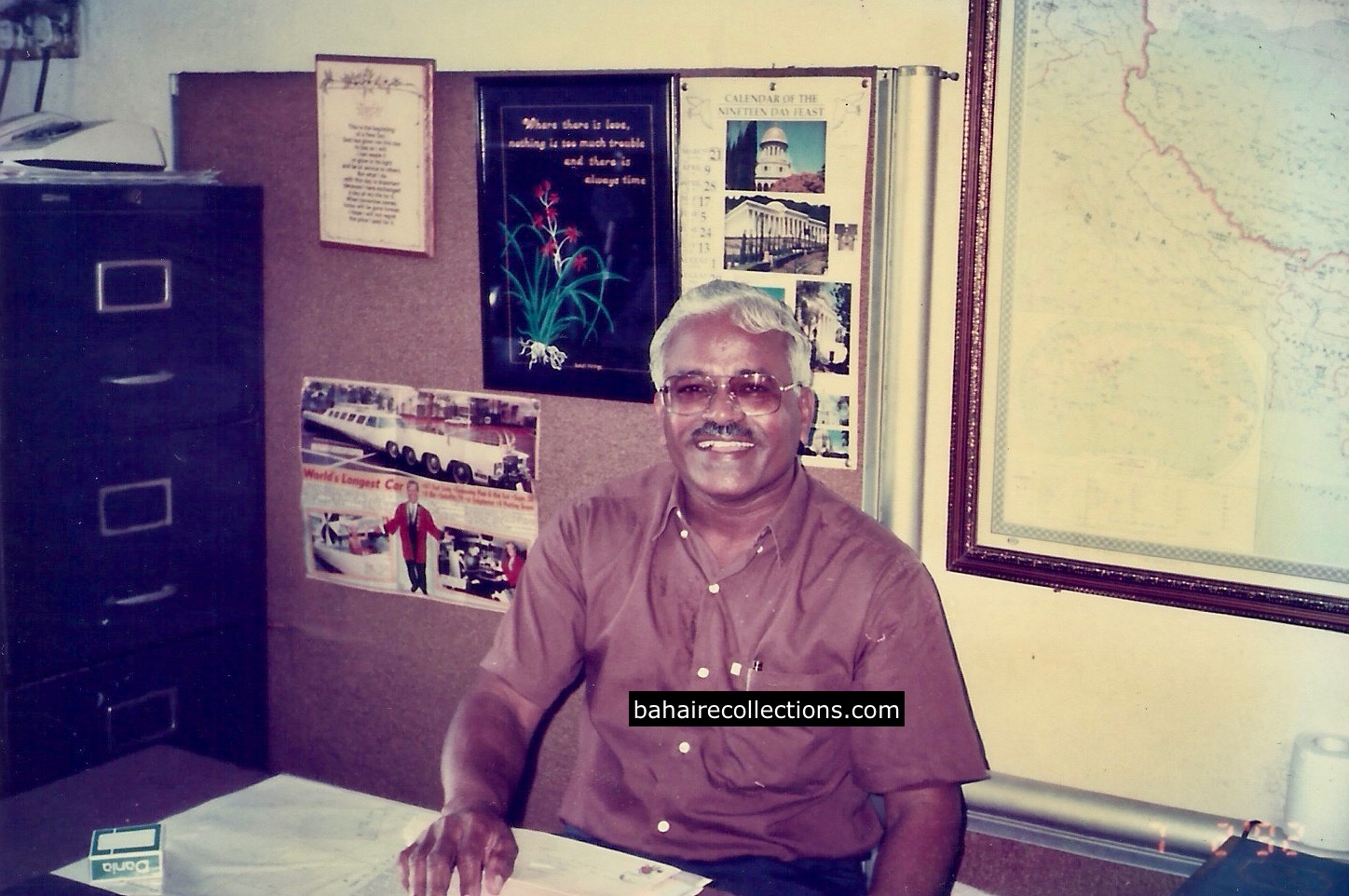
Jami in his office of ZARINA ENTERPRISE in Kajang
Since the Local Spiritual Assembly in Kajang was still in its nascent form, Jami found it his duty to take upon himself the task of protecting the image of the Cause by weeding out unwanted elements in the community. Somehow Jami Maniam was gifted with an uncanny knack for detecting trouble in advance and acted accordingly. He ensured to keep the institutions informed of such difficult situations.
Likewise, he took upon himself the vital duty of deepening the believers into maturity. At the Feasts and holy days, he would give talks on their significance, and get the local believers to read prayers, and passages from the writings. As the Local Spiritual Assembly matured, this protection of the Cause was passed on to this divine institution.
Jami was one of those very few having cars in the early days. He had a Mazda station wagon in which he would provide transport for those who needed transport for Bahá’í activities. For local activities, Jami would make a few trips before the event to bring the believer to the Bahá’í Centre and send them home after the event each time. And Jami was always the last to return home and retire to bed. He had taken many to conferences held in other parts of the country.
Whenever Bahá’í projects needed funding, Jami used to empty his pockets, and if needed even sought loans, often without the knowledge of others. He ensured the needs of the Faith were above his own personal needs. If there was one person on whom the community could count on during moments of heedlessness, it was invariably Jami. He was always there for the believers whenever they faced great difficulties. He was always there to provide assistance for all family functions and was about the earliest to arrive when someone passed away. Jami was the greatest consolation for the individuals and community.
When the community decided to take up projects, Jami was the foremost supporter who was in the frontline. Whenever any goal was given by the national institution of committees, he was almost the first to start implementing them, as a very strong supporter of the institutions. From the time the national institution purchased a piece of land in the nearby town of Balakong to be used as a training centre, Mr. Appu Raman, followed by Jami were entrusted along with others in developing it. Jami and Mr. Steven Chang Sin teamed up to develop the property in their overflowing love for the national institution. Steven bought a piece of land near the site and built his home there to be at the site almost every day. Jami on his part involved many believers in his Kajang community to work in the property in the spirit of universal participation. He would assign each individual the tasks to be carried out and inform them on what equipment and cleaning tools to be brought along. He got all members of his family involved as well. On several weekends the family used to pack their meals and set out early in the morning to Balakong to clear the land, with the neighbours guessing they were out for a picnic. Jami himself was there with others each week, and sometimes each day to clear the terrain. He carried out his duties energetically and with great commitment and dedication to maintain the property that was later named Yankee Leong Training Institute. Whenever major gatherings were planned to be held, Jami ensured he went to the site to ensure water, electricity, parking, and bedding facilities were in place. This building became a centre of many gatherings that included summer schools, deepening sessions, visits by members of the Supreme Body, and national conventions.
Numerous were the projects of the community when Jami gave his fullest support, at times pouring out financial assistance to ensure that the projects became a huge success. Some of the landmark events in the community where members took pride were the staging of the first professional drama in the Tamil language entitled the Seven Martyrs of Tehran in 1990, and the staging of another similar drama on Táhirih in 1992, both in the Yankee Leong Training Institute. Yet one more landmark project was the cassette recording of Bahá’í devotional songs in the Tamil language during the same period. In these and similar other projects, Jami was deeply committed, highly emotional and emptied his pockets quietly to ensure their huge success. In the teaching projects too, Jami was on the frontline. He joined the friends to take the Cause to some far-off places and return past midnight. Jami was also the strongest supporter and stoutest defender of the Local Spiritual Assembly. He had served in several national and regional committees. Jami was the longest-serving Chairman of the Regional Teaching Committee of Selangor state starting from the 1970s. For a brief period, he had served as Assistant to an Auxiliary Board member.
Jami’s life was filled with Bahá’í activities and yet interspersed with health issues. It was in the late 1970s that he developed high blood pressure and was admitted into hospitals several times. Despite his ailment, he continued to serve the Cause, sadly neglecting his health. In 1980, the Supreme Body urged the National Spiritual Assembly of Malaysia to assist in the rebuilding of the Bahá’í community in Myanmar. In April 1980 the first team was sent to Myanmar. Jami joined this team despite his failing health. Yet in Myanmar, he was teaching the believers with full strength and vigour of an ably bodied youth. There was an old unused cyclostyling kept in the Bahá’í Centre of Yangon for years. As soon as Jami’s eyes fell on that machine on the day of his arrival in Yangon, he spent a few hours repairing it to usable condition. The local believers started using the machine with great happiness, and circulars started to be produced.
Providing hospitality to visitors was one area in which Jami and his wife excelled. There could be no visitor who would have walked out of their home without any meal, however simple it could have been. There were times when they were subjected to much criticism for providing great hospitality, but that did not diminish their spirit continuing with an activity that genuinely pleased their hearts. At a time when home visits were not institutionalized, Jami and his wife made it a point to visit isolated believers and give them strength by conducting deepening classes. The couple had taken this as their personal goal. Numerous had been the friends who were quickened by such gestures. The couple also initiated the family-exchange program, in which they would invite children from other families to stay with them during school holidays. Their children would go over to the other families during the next holiday season. Many children were nurtured in this way, including the children of the late Mr. Gopal of the Dengkil community. The last major gathering the couple attended together was the Second Bahá’í World Congress held in New York in November 1992.
From the time Jami resigned from the government service in 1969, he started off well in his business. Towards the end, Jami could not manage the typewriter servicing business as most of his clients had switched from traditional typewriters to desktop computers. With the failing business, Jami ventured into a few other businesses which too did not work out too well. Yet he spent time going through the Writings to console himself. He was a collector of Bahá’í books and an avid reader himself. But never for once did he flinch in serving the Cause. The couple ensured Naw-Rúz, and all the Holy Days were celebrated each year without fail until two years before Jami himself was immobilised when he was bedridden from a stroke. The couple used the celebration of Holy Days as proclamation events by inviting their friends.
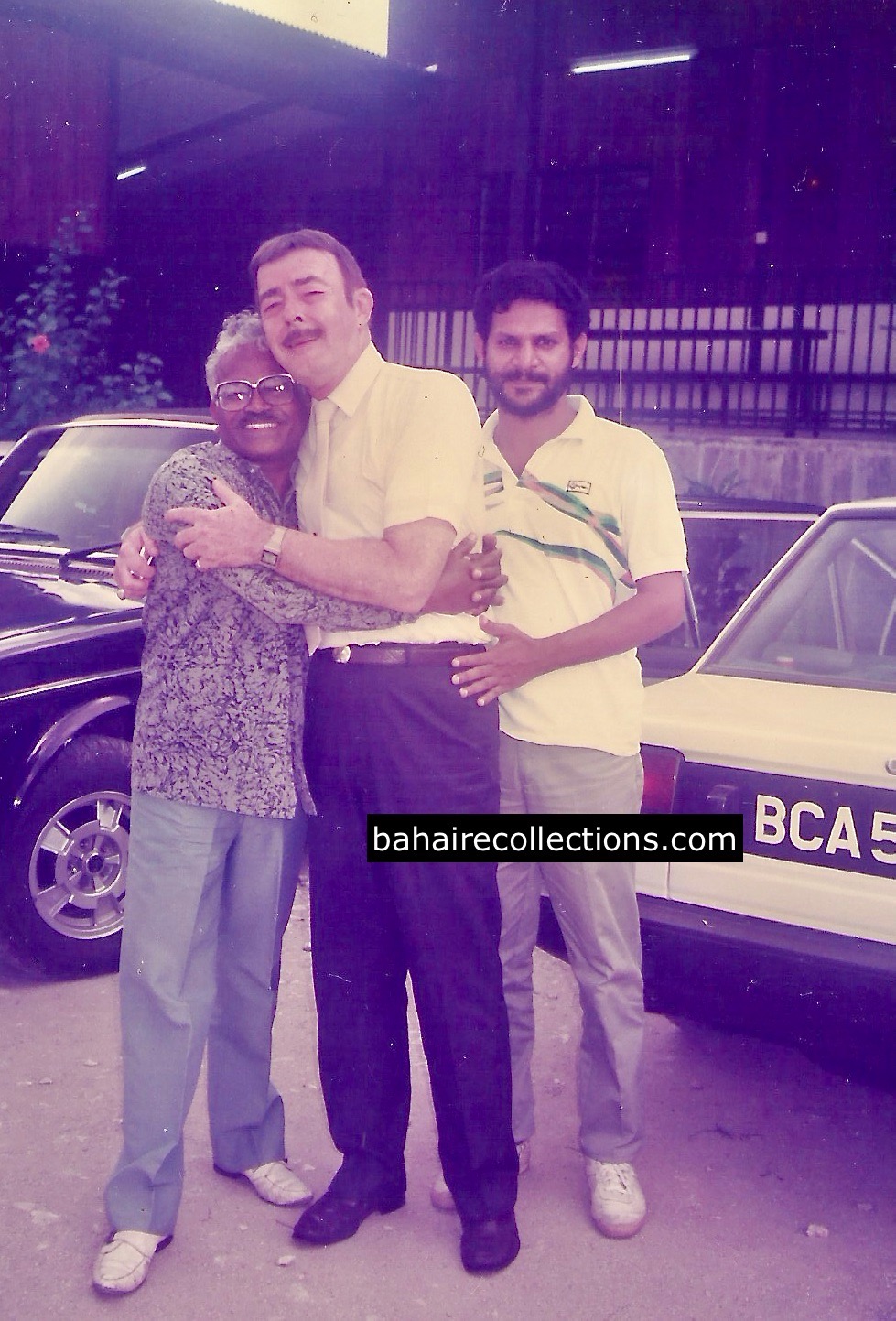
With Jack Davis in the middle and Jeyenthan at the Yankee Leong Bahá’í Institute, Balakong, 1989. Jack Davis was in Malaysia to conduct spiritualisation courses
He was a very creative person from the early days, venturing into many areas including fish-breeding and farming. There was a brief period when Jami sold cars of Continental making with Japanese engines. Jami and a few believers with modest income were thus enabled to own cars with bodies of Jaguar and Mercedes Benz. Jami himself went for a Jaguar car with which he was able to take the Cause to some sectors highly and eminently placed in society. He knew the way into higher society was through the way those in those societies desired.
Jami sought the advice of elders in the Faith, one of them, Dr. Chellie John Sundram whenever needed. Once Dr. Chellie stayed in a hotel in Kajang town and phoned Jami to come over to the hotel, where they spoke till past midnight. Dr. Sundram, apart from discussing the future progress of the Cause in Kajang, advised him on how to handle difficult persons and difficult situations. He then spoke on the strategy for Jami to employ in his overcoming his business dealings which witnessed a financial reversal. Dr. Sundram had advised Jami to give preference to cash dealings, rather than running his business on credits. Dr. Sundram had said that “It is better to get M$ 20.00 in cash than getting a post-dated cheque for M$ 200.00”. It was through this advice that Jami was able to reduce and finally set off his huge business debts, for which Jami remained grateful to Dr. Sundram. Jami was a good painter but decided to exert his energy for the promotion of the Cause on the advice of his close friend Counsellor Dr. Chellie Sundram, himself a great painter.
It was the negligence of his health that ultimately led to Jami being rushed by ambulance and hospitalised several times. In 2004, Jami had a major stroke and was rushed to hospital. He developed impairment in walking and doctors had given up hope. But Jami, as a man of strong willpower fought through and walked out of the hospital, with the doctors blinking away. It did not take long before he started to slow down in activities. He was once again bedridden following repeated incidents of stroke in 2008. He recovered in 2009 and as soon he was mobile again, he was bent on fulfilling his lifelong desire- to go on pilgrimage. Jami went for pilgrimage, together with his wife from 24 May to 2 June 2010, and returned home with a sigh of great relief that he had achieved his heart’s desire. It did not take long before Jami was once again bedridden for over the next two years, with his wife and children taking care of him. There was a continuous flow of visitors ranging from the believers of the 1950s right to the current generation from across the country. Having completely lost his speech, Jami used sign language requesting visitors to pray for his early departure to the next world.
He passed away peacefully in sleep on 27 November 2013 and was laid to rest at the Bahá’í Memorial Park in Seremban, following a befitting memorial service. His wife was abroad in India when Jami passed away. She was catering to the needs of Jami continuously until her own health was very badly affected. The children, fearing her failing health condition, persuaded with great difficulties, and sent her away to India for some rest, promising that they would take over the responsibilities of caring for him in her absence. At the time of his passing, she could not be contacted despite several efforts. The children with the assistance of the Local Spiritual Assembly of Hulu Langat, and some relatives gave this great worker of the Cause a befitting burial at the Bahá’í cemetery in Seremban. It was only upon the arrival of Mrs. Subbamah at the airport that was the children informed her of the passing of her late husband by her children. Despite receiving the unexpected and shocking news, she tried to remain calm and enquired if her late husband was given a befitting and memorable funeral. She broke down to tears once she set foot into the empty house. She was completely devastated by that great loss and refused to meet any visitors over the next remaining days of her life. She herself passed away on 12 February 2018 following a short period of suffering from a terminal illness.
Throughout his life, he devised personal goals, often without much publicity, and when needed, kept only the institutions informed. Whenever he learnt of the sufferings of fellow believers he not only visited them uninvited but offered assistance and prayed for them until their problems were resolved or mitigated. His greatest happiness was to see the success of Bahá’í projects. In his association with youths, he always insisted on a high rectitude of conduct and character, and he tried his very best not to compromise in Bahá’í morals, although at moments he could have faced his own challenges. Whenever those downtrodden visited him to pour out their problems, Jami would quote from the Writings and advise and guide them from the tenets of the Faith.
He was often outspoken and hard-hitting too, all for caring for the good image of the Faith. But deep inside, Jami was a very warm person. There was no reported incident of Jami losing his temper. His love for the Faith was so immense and boundless that he wished to identify everything he did was associated with the Faith. One was the registration number of his car. In 1972 N. S. S. Silan, a member of the National Spiritual Assembly of Malaysia, on learning that the registration number of “BAB 1844” was coming up soon, booked the number for his own car through the Road Transport Department of Malaysia. When Silan won the bid, he had to leave for travel teaching to Africa at the end of 1972. Silan then asked around if anyone was interested in having that registration number plate, and Jami immediately rushed forward with all eagerness, grabbed it with great pride and overwhelming joy, and installed it onto his own Datsun car. After each drive in the car, Jami washed the registration plates in the front and rear of the car and maintained its cleanliness, not the entire body of the car as such. His arrival in that car at conferences became a sight to behold, and friends gathered around him and the car for obvious reasons. It did not take long before Jami realized that the car registration number was sending out somewhat different kind of signals at gatherings- relating the number plate with The Bab, the Herald of the Bahá’í Faith. Just then, another believer came forward and insisted on the registration number, and Jami passed it to him.
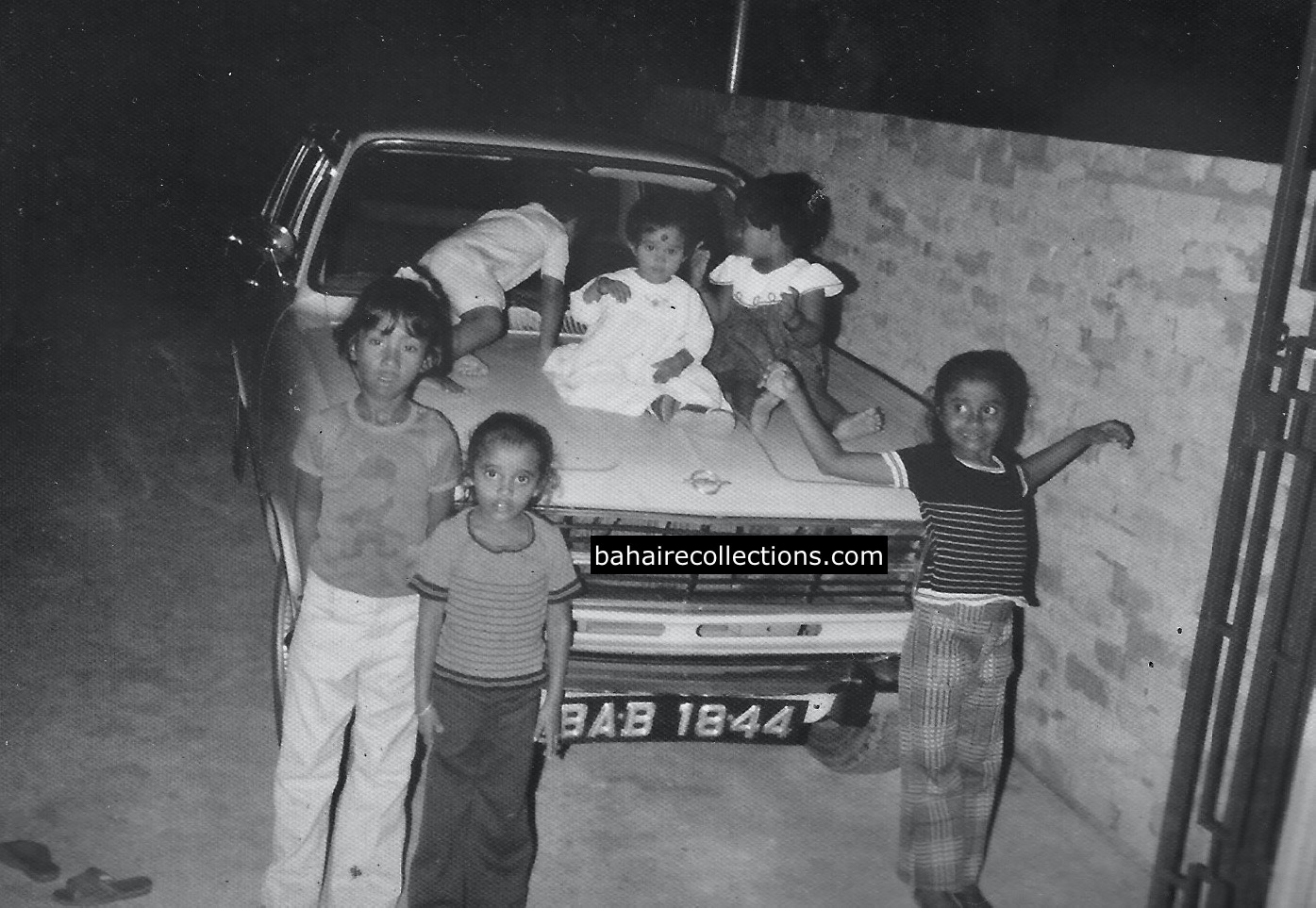
The car with Registration number BAB 1844
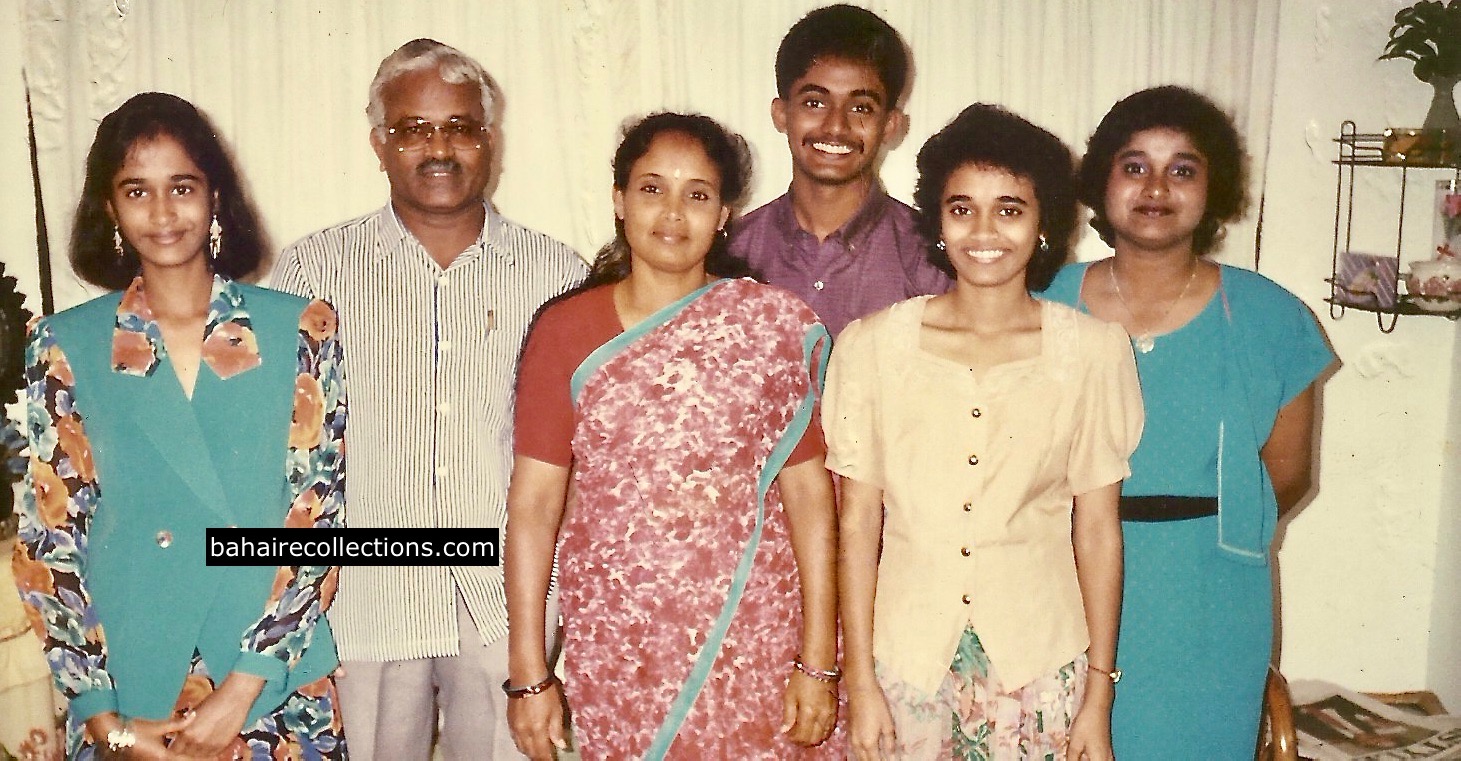
Family of Jami. L-R: Shahin, Jami, Mrs. Jami, Rooha, Zanariah, and Zarina
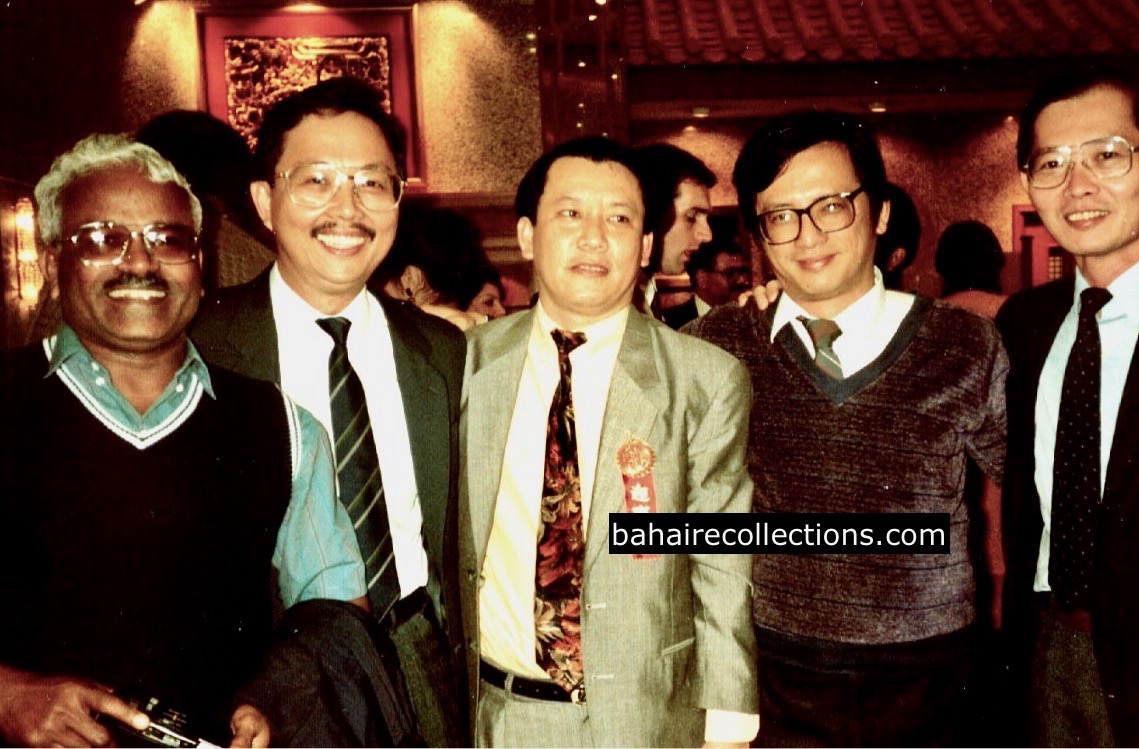
Chinese Teaching Conference in Macau, 1991. L-R: Jami Maniam, T. K. Lee, Francis Ng, Lum Weng Chew and Yin Tin Shih. Jami, not on the International Chinese Teaching Committee turned up for the conference
In the 1990s there was a call for Malaysians to go to China. Fired by the overwhelming devotion for the Cause and heeding to the call, Jami sent his only son Rooha as a student pioneer to China. In 1992 and 1993 Rooha studied at Zhongshan University, Guangzhou, and from 1993 to 1995 studied at Sichuan University, Chengdu. In the three years in China, Rooha studied Mandarin.
The immense love and obedience he had for institutions was something to be admired and emulated by the new generation. Whenever the national institution sent out messages, Jami would further encourage the community to read them and abide by them. Throughout his life, he used to spend hours going through all the communications from the Supreme Body and strained to grasp the meanings of the messages and shared with the local believers during Feasts.
Jami gave all his support to anyone who arose to serve in any capacity, with no trace of any jealousy, hate, or envy. There was no fear on the part of Jami Maniam of someone else outshining him as Jami always considered himself lowly among the servants of God. Yet he would push people with the capacity to exert their talents to the maximum.
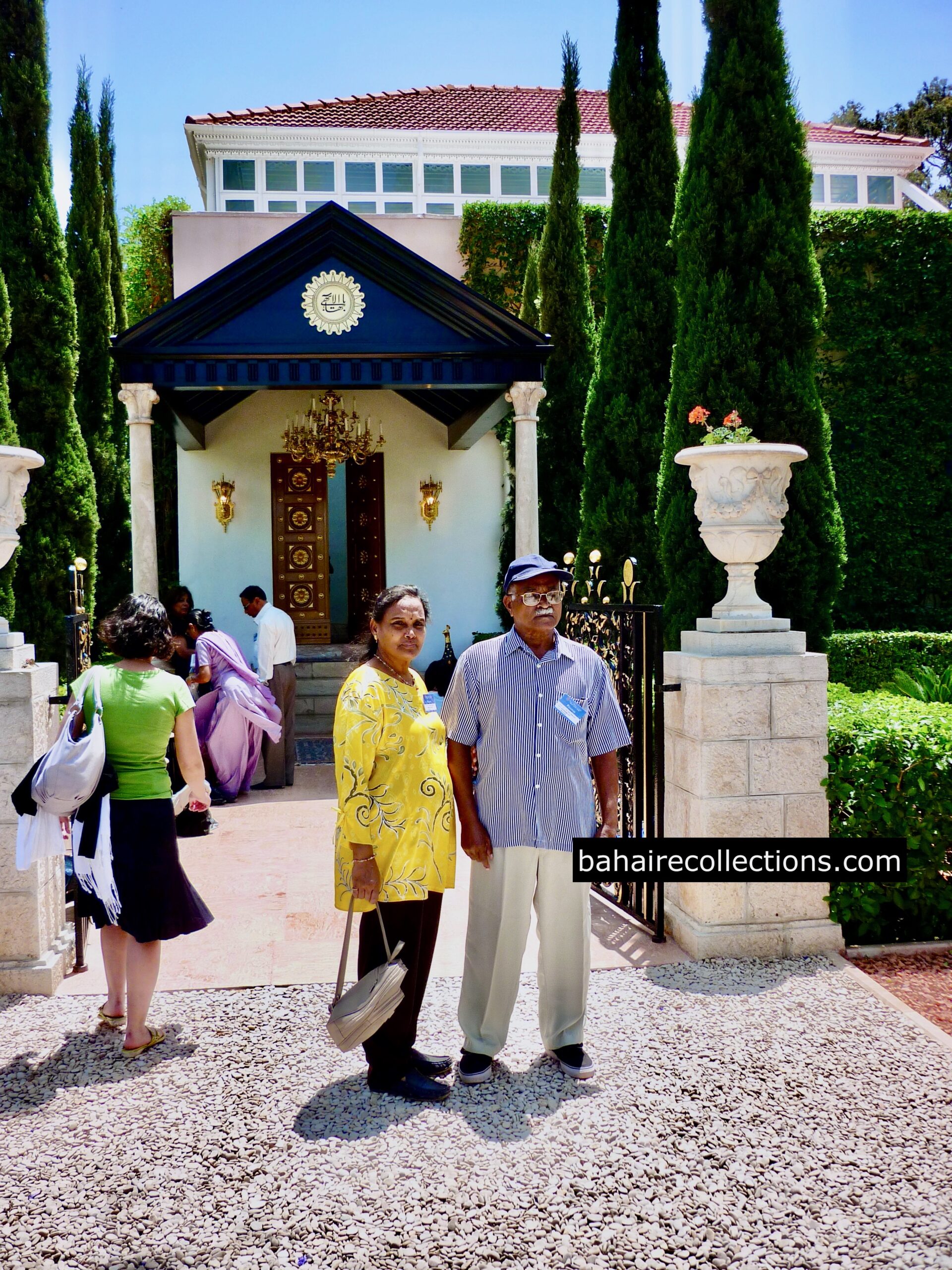
Pilgrimage, a life-long desire finally fulfilled at the end of his life in 2010
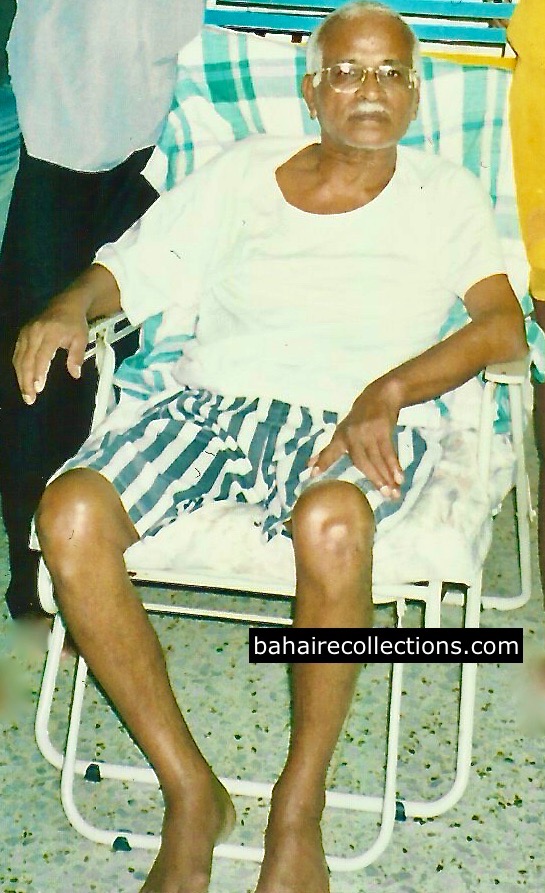
Jami at his last days, when still able to converse with visitors
Thus ended the life of Jami, worn out and burnt out with constant and continuous energy fully exerted in promoting the Cause he loved and served. The life of Jami has been well spent, basking throughout his earthly days under the shelter of the Blessed Beauty. He loved and served the Faith to the best possible ability. He tried to give the best and prime part of his life to the Cause of God. He may have had his own shortcomings, like any other believer. The greatness of this believer was that he ensured the tests and tribulations he went through in no way interfered with the constant and inspiring service. He has certainly left some indelible traces in his own way of loving and serving the Faith, which is already acknowledged by the old-time believers. Jami was one who would carry out a task, however difficult it may appear once he had made up his mind. He always had a never-say-no attitude towards work that needed to be achieved. Throughout his life, Jami had a kind of missionary zeal and a resolute determination in achieving anything he wanted for the Faith. His legacy shall forever remain intact and endure in the deepest recesses of our hearts. Jami has set good examples in many ways which are sure to be emulated by generations yet to be born.
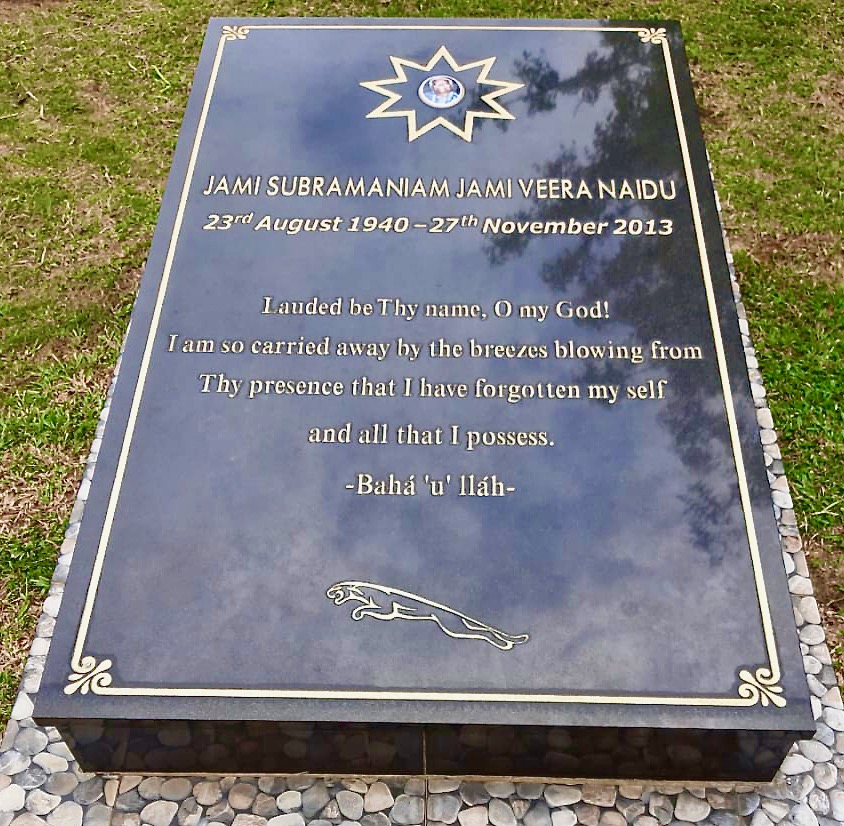
Resting Place of Jami Maniam at the Bahá’í Memorial Park, Seremban
A. Manisegaran
30 November 2021
You may leave your comments at: info@bahairecollections.com
Copyright@bahairecollections.com